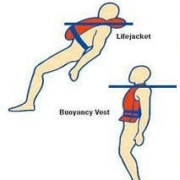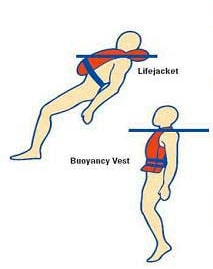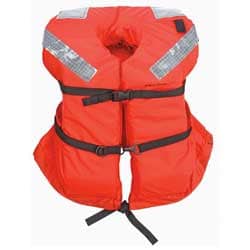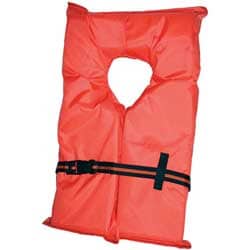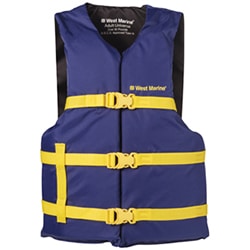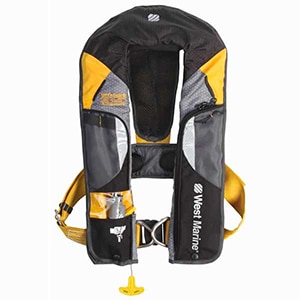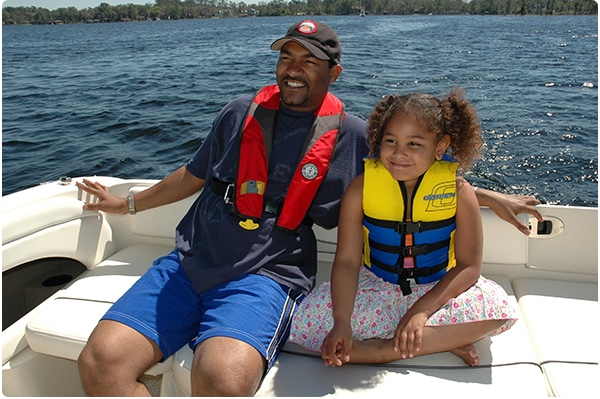Types of PFDs
Types of PFDs
Here is a graphical explanation between a lifejacket and a buoyancy vest.
PFD Type ratings are being phased out and replaced with new standard ratings that better deal with materials and buoyancy. However for now until this phase-out is complete internationally, it is prudent to know the below because it still works. If your country is not using “Types” take note of the recommended use of the PFD and use accordingly. There is not any necessary shape or design that defines a Type – when purchasing you just need to know the type used and see the rating listed on the PFD.
Type Ratings
TYPE I PFDS / OFF-SHORE LIFE JACKETS: Best for all waters, open ocean, rough seas, or remote water, where rescue may be slow coming. Abandon-ship lifejacket for commercial vessels and all vessels carrying passengers for hire:
- Inherently Buoyant Type I PFDs
- Inflatable Type I PFDs
- Hybrid Type I PFDs
A Type I Rated Offshore Life Jacket
TYPE II PFDS / NEAR-SHORE BUOYANT VESTS: For general boating activities. Good for calm, inland waters, or where there is a good chance for fast rescue.
- Inherently Buoyant Type II PFDs
- Inflatable Type II PFDs
- Hybrid Type II PFDs
A Type II Inshore Rated Life Jacket
TYPE III PFDS / FLOTATION AIDS: For general boating or the specialized activity that is marked on the device such as water skiing, hunting, fishing, canoeing, kayaking, and others. Good for calm, inland waters, or where there is a good chance for fast rescue. Designed so that wearing it will complement your boating activities:
- Inherently Buoyant Type III PFDs
- Inflatable Type III PFDs
- Hybrid Type III PFDs
A type III Rated Buoyancy Vest
TYPE V PFDS / SPECIAL USE DEVICES: Only for special uses or conditions.
See label for limits of use:
- Hybrid Inflatable PFDs
- Canoe/Kayak Vest
- Boardsailing Vests
- Deck Suits
- Work Vests for Commercial Vessels
- Commercial Whitewater Vests
- Man-Overboard Rescue Devices
- Law Enforcement Flotation Devices
A Type V Inflatable PFD with Type II performance
TYPE IV are throwable Ring Buoys and Boat Cushions. Regulations cover that there must be a number of these on board as well. Usually, for smaller boats, it is one. A Type IV is not to be included in the count of one PFD for each person on board
A Type IV Throwable PFD
Buoyancy Ratings
PFDs/life jackets are graded with a buoyancy rating that lists the amount of buoyancy force a PFD can hold expressed in units of newtons (N). Force is used rather than weight because force is a constant whether submerged in water or not, whereas our weight changes if we are submerged in water. On Earth (out of water) one Newton force is about 1/10th of a kilogram.
Life jackets are rated in the following Buoyancy Rating Categories:
275 N—150 N—100 N—50 N
For example, a 150 N life Jacket provides 150 N of floating force. If a rock on the bottom of the ocean weighed 14 kg on a submerged weight measurement scale, then a 150 N-rated life jacket would hold it afloat—barely. A 15 kg rock with a 150 N life jacket would have neutral buoyancy.
A 200-pound (91-kilogram) man requires about 10 pounds (4 kilograms) of buoyancy. The math here uses the person’s body makeup of 80 percent water (neutral buoyancy) and 15 percent fat (positive buoyancy). 4 kg converts to 40 newtons. Thus, the 150 newtons are plenty for the average person and considered the minimum for an adult in offshore conditions.
The decision now comes down to comfort, purpose, and anti-drowning assistance. For example here is an infant/child life jacket that has an automatic roll onto the back feature.
Here is a demonstration. Of note – the father was much more comfortable to dump the toddler’s head completely under than the mother. LOL.
Offshore use requires much more thought and investigation. Make sure however that your PFD comes with a D-ring to clip into safety jack lines.
Inflatable PFD’s
Chances are that you will be switching over to an inflatable PFD pretty soon; especially now that we have convinced you to wear a comfortable PFD.
Inflatable PFDs are life-critical, semi-complicated devices that need proper maintenance and attention. They inflate when immersed in water either by detecting hydrostatic pressure or by a pill that dissolves when it comes in contact with water. The pressure bottle that holds the compressed air can be used only once and the mechanism that fires the pin to pierce the seal on the compressed air bottle must also be reset and replaced. Additionally, they need to be inspected annually. Beyond all that, however, once you realize how comfortable (and sometimes stylish) they are, you’ll be happy you’ve made the transition.
We have posted additional information about the care and use of inflatable PFDs if you care to learn more on our blog site here:
Above the adult is wearing a Type II inflatable PFD while the Child is wearing a Type III comfortable PFD.


